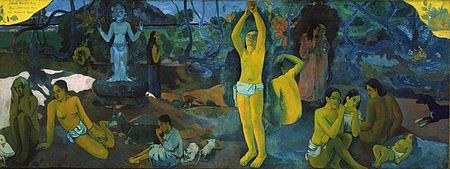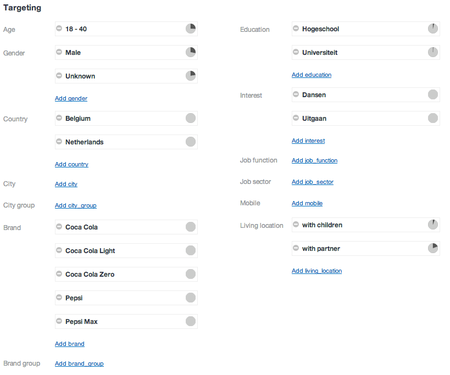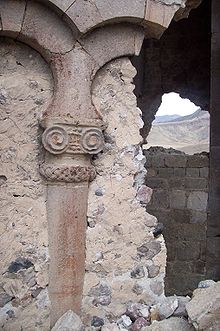Bana cathedral
| |||||||||||||||||||||||||||
Read other articles:

Artikel ini sebatang kara, artinya tidak ada artikel lain yang memiliki pranala balik ke halaman ini.Bantulah menambah pranala ke artikel ini dari artikel yang berhubungan atau coba peralatan pencari pranala.Tag ini diberikan pada Desember 2022. Sukhoi Su-25SM adalah sebuah pesawat tempur varian Sukhoi Su-25, bermesin ganda dengan pendorong jet diroduksi di Uni Soviet oleh Biro Perancang Sukhoi. Su-25SM (Stroyevoy Modernizirovannyi) adalah program upgrade untuk Su-25 terjangkau, dikandung oleh A…

Union ibérique 1580–1640 Carte de l'Union ibérique.Informations générales Capitale Madrid, Lisbonne Histoire et événements 1580 Union du Portugal et de la Monarchie catholique 1640 Séparation du Portugal et de la Monarchie catholique Entités précédentes : Royaume de PortugalMonarchie catholique Entités suivantes : Royaume de PortugalMonarchie catholiqueRépublique catalane modifier - modifier le code - voir Wikidata (aide) L'Union ibérique est l'expression historiographiq…

National park and nature reserve in West Bengal, India This article needs additional citations for verification. Please help improve this article by adding citations to reliable sources. Unsourced material may be challenged and removed.Find sources: Sundarbans National Park – news · newspapers · books · scholar · JSTOR (March 2017) (Learn how and when to remove this message) Sunderbans National ParkIUCN category II (national park)Tiger from Sundarbans Tig…

Disambiguazione – Se stai cercando la Nazionale femminile, vedi Nazionale di pallacanestro femminile della Finlandia. Finlandia Uniformi di gara Casa Trasferta Sport Pallacanestro Federazione Federazione cestistica della Finlandia Confederazione FIBA (dal 1939) Zona FIBA FIBA Europe Allenatore Lassi Tuovi Ranking FIBA 20º Olimpiadi Partecipazioni 2 Medaglie - Mondiali Partecipazioni 1 Medaglie - FIBA EuroBasket Partecipazioni 17 Medaglie - La nazionale di pallacanestro della Finlandia (Suomen…

Village in Neath Port Talbot, Wales Abergarwed is a village in the Welsh county borough of Neath Port Talbot, south Wales. It is located in the Vale of Neath, in the electoral ward of Resolven, near the town of Neath. External links www.geograph.co.uk : photos of Abergarwed and surrounding area vteNeath Port TalbotNeath Port Talbot County Borough CouncilCommunities Aberavon Baglan Baglan Bay Baglan Moors Blaengwrach Blaenhonddan Briton Ferry Bryn Cilybebyll Clyne and Melincourt Coedffranc C…

Частина серії проФілософіяLeft to right: Plato, Kant, Nietzsche, Buddha, Confucius, AverroesПлатонКантНіцшеБуддаКонфуційАверроес Філософи Епістемологи Естетики Етики Логіки Метафізики Соціально-політичні філософи Традиції Аналітична Арістотелівська Африканська Близькосхідна іранська Буддійсь…

Conceptual approach that draws upon multiple theories, styles, or ideas The grand foyer of the Palais Garnier, by Charles Garnier, 1860–1875. Stylistically, it aimed for a Baroque opulence through lavishly decorated monumental structures that evoked Louis XIV's Versailles. However, it was not just a revival of the Baroque, being more of a synthesis of Classicist styles, like Renaissance, Baroque, Rococo, Neoclassicism etc. Thus, it is an example of eclecticism. Early Romanian Revival house on …

梅拉蒂·达伊瓦·奥克塔维亚尼Melati Daeva Oktavianti基本資料代表國家/地區 印度尼西亞出生 (1994-10-28) 1994年10月28日(29歲)[1] 印度尼西亞万丹省西冷[1]身高1.68米(5英尺6英寸)[1]握拍右手[1]主項:女子雙打、混合雙打職業戰績48勝–27負(女雙)109勝–56負(混雙)最高世界排名第4位(混雙-普拉文·喬丹)(2020年3月17日[2])現時世界排名第6位…

Former village in Isfahan province, Iran For the village in Kurdistan province, see Nowgaran. For other places with a similar name, see Guran. Former Village in Isfahan, IranNow Guran Persian: نوگورانFormer VillageNow GuranCoordinates: 32°23′04″N 51°13′55″E / 32.38444°N 51.23194°E / 32.38444; 51.23194[1]CountryIranProvinceIsfahanCountyLenjanDistrictCentralRural DistrictKhorram RudPopulation (2011)[2] • Total3,213Time zon…

Former country in present southeastern Nigeria Aro ConfederacyOmu Aro1640–1902 FlagCapitalArochukwuCommon languagesIgboIbibioEkoiIjawEfikand othersGovernmentConstitutional monarchyHistorical eraEarly modern• Established 1640• Disestablished 1902 CurrencyManillasCowry shellsSlaves Preceded by Succeeded by Aro people Colonial Nigeria Today part ofNigeriaCameroonEquatorial GuineaGabon Part of a series on theHistory of Nigeria Timeline Early history pre-1500 Nok culture 1500-1 B…

Far East Reporter1970 cover pageEditorMaud RussellCategoriesPolitics, economics, social issuesFrequencyIrregularFounded1952Final issue1989CountryUnited StatesBased inNew York City The Far East Reporter was a magazine or newsletter published in New York City on an irregular schedule from 1953 to 1989 by Maud Russell. It took the form of pamphlets that mainly talked sympathetically about China under Mao Zedong. History Maud Russell was the executive director of the Far East Spotlight magazine, whi…

Form of advertising This article may need to be rewritten to comply with Wikipedia's quality standards, as it has formatting, tone, and possibly other issues. You can help. The talk page may contain suggestions. (January 2017) This article contains content that is written like an advertisement. Please help improve it by removing promotional content and inappropriate external links, and by adding encyclopedic content written from a neutral point of view. (June 2023) (Learn how and when to remove …

1998–2003 Japanese manga series Hikaru no GoFirst tankōbon volume cover, featuring Hikaru Shindoヒカルの碁GenreComing-of-age[1]Sports[2]Supernatural[3] MangaWritten byYumi HottaIllustrated byTakeshi ObataPublished byShueishaEnglish publisherNA: Viz MediaImprintJump ComicsMagazineWeekly Shōnen JumpEnglish magazineNA: Shonen JumpDemographicShōnenOriginal runDecember 8, 1998 – July 14, 2003Volumes23 (List of volumes) Anime television seriesDirected…

English army officer and politician Cobham John Cavendish Lyttelton, 9th Viscount Cobham, KCB, DL (23 October 1881 – 31 July 1949), was a British peer, soldier, and Conservative politician from the Lyttelton family. Biography Cobham was the eldest son of Charles Lyttelton, 8th Viscount Cobham, and the Hon. Mary Susan Caroline Cavendish, daughter of William Cavendish, 2nd Baron Chesham. Alfred Lyttelton was his uncle. He was educated at Eton. Like his father and his uncle, Cobham was a …

Disambiguazione – Se stai cercando altri significati, vedi Campionato mondiale costruttori. Il campionato mondiale costruttori di Formula 1 (in inglese Formula One World Constructors' Championship, abbreviato WCC) viene attribuito ufficialmente dalla Federazione Internazionale dell'Automobile ed è determinato da un particolare sistema di punteggio, che nel corso degli anni è variato, basato sui risultati ottenuti in ogni Gran Premio. Indice 1 Criterio 2 Statistiche 3 Albo d'oro 3.1 Per stagi…

Compact car This article is about the compact car produced since 2008. For the subcompact car produced between 2001 and 2008, see Suzuki Ignis. Motor vehicle Chevrolet Cruze2017 Chevrolet Cruze LT sedanOverviewManufacturerGeneral MotorsAlso calledDaewoo Lacetti Premiere (2008–2011)Holden Cruze (2009–2016)Holden Astra Sedan (2016–2019)Production2008–2023[1]Body and chassisClassCompact car (C)LayoutFront-engine, front-wheel driveChronologyPredecessorDaewoo/Chevrolet Lacetti/Ch…

Ini adalah nama Tionghoa; marganya adalah Ong. Ong Ye Kung BiografiKelahiran15 November 1969 (54 tahun)Singapura Minister for Health (en) 15 Mei 2021 – ← Gan Kim Yong Minister for Transport (en) 27 Juli 2020 – 14 Mei 2021 ← Khaw Boon Wan – S. Iswaran → Minister for Education (en) 1r Mei 2018 – 26 Juli 2020 ← Ng Chee Meng – Lawrence Wong → Minister for Education (en) 1r Oktober 2015 – 30 April 2018 ← …

Questa voce sull'argomento aerei è solo un abbozzo. Contribuisci a migliorarla secondo le convenzioni di Wikipedia. Segui i suggerimenti del progetto di riferimento. Fieseler Fi 98DescrizioneTipobombardiere in picchiata Equipaggio1 Costruttore Fieseler Esemplari1 Dimensioni e pesiLunghezza7,40 m Apertura alare11,50 m Altezza3,00 m Superficie alare25,50 m² Peso a vuoto1 450 kg Peso carico2 160 kg PropulsioneMotoreun radiale BMW 322 H-2 Potenza650 PS (478 kW) PrestazioniVelocità …

Ayub 11Kitab Ayub lengkap pada Kodeks Leningrad, dibuat tahun 1008.KitabKitab AyubKategoriKetuvimBagian Alkitab KristenPerjanjian LamaUrutan dalamKitab Kristen18← pasal 10 pasal 12 → Ayub 11 (disingkat Ayb 11) adalah bagian dari Kitab Ayub di Alkitab Ibrani dan Perjanjian Lama dalam Alkitab Kristen. Kitab ini menceritakan riwayat Ayub, seorang yang saleh, dan pencobaan yang dialaminya.[1][2] Teks Naskah sumber utama: Masoretik, Septuaginta dan Naskah Laut Mati. Pasal …

998 GRT coaster History Name Günther Russ (1921-45) Empire Condorrat (1945-47) Kenton (1947-50) Günther Russ (1950-57) Owner Schiffart-und Assekuranz Gesellschaft GmbH (1921-45) Ministry of War Transport (1945) Ministry of Transport (1945-47) Whitehaven Shipping Co (1947-50) Ernst Russ (1950-57) Operator Ernst Russ (1921-45) Ministry of War Transport (1945) Richard R Chester Ltd (1945-47) Whitehaven Shipping Co (1947-50) Ernst Russ (1950-57) Port of registry Hamburg (1921-33) Hamburg (1933-45)…









